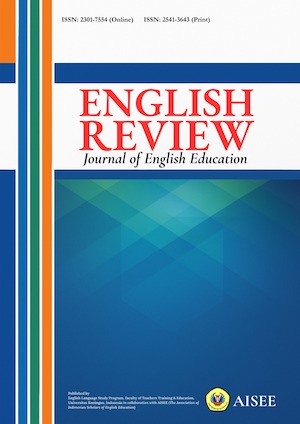RELOADING THE DRAGON LADY: READING THE CHARACTER OF CHUN LI IN STREET FIGHTER: THE LEGEND OF CHUN LI
Abstract
Street Fighter: The Legend of Chun Li movie revolves around the journey of Chun Li, a Chinese female fighter of the Street Fighter series, and her eventual fight against Bison. This study focuses on the portrayal of Chun Li as a representative of Asian women in an American movie, and compares it to her original portrayal in the game. There are two big groups of representation of Asian women in the Western media: the submissive ‘lotus blossom baby’ and the aggressive ‘dragon lady.’ As a form of content analysis, this study analyzes both textual and visual elements of the Street Fighter: The Legend of Chun Li movie and Street Fighter game series which represent the portrayal of an Asian woman character named Chun Li. Result shows that Chun Li character in the movie leans more towards the ‘dragon lady’ group with her strong and seductive characteristics, while her game self exhibits a broader range of qualities.References
Besana, T., Katsiaficas, D., & Loyd, A. B. (2019). Asian American media representation: A film analysis and implications for identity development. Research in Human Development, 16(3-4), 201-225.
Brown, J. A. (2004). Gender, Sexuality, and Toughness: The Bad Girls of Action Film and Comic Books. In Action Chicks (pp. 47–74). Palgrave Macmillan, NewYork.https://doi.org/10.1057/9781403981240_3
Chin, J. (2011). Mongrel: Essays, Diatribes, and Pranks. New York: St. Martin Press.
Clark, A. W. (2012). Disturbing Stereotypes: Fu Man/Chan and Dragon Lady Blossoms. Asian American Literature Discourses & Pedagogies, 3, 99-118.
Furfari, P. (2010). Top 50 Street Fighter Characters. UGO.Com. http://www.ugo.com/games/top-50-street-fighter-characters.html
Gerbner, G. (1998). Casting the American Scene : A Look at the Characters on Prime time and Daytime Television from 1994-1997.
Hagedorn, J. (1997). Asian Women in Film: No Joy, No Luck. In Facing Diferrence: Race, Gender, and Mass Media (Vol. 1, pp. 32–37).
Hoeveler, D. L., & Cass, J. (Eds.). (2006). Interrogating orientalism: contextual approaches and pedagogical practices. Ohio State University Press.
Hoppenstand, G. (1992). Yellow devil doctors and opium dens: The yellow peril stereotype in mass media entertainment. In Nachbar, J. G., & Lause, K. (Eds.). Popular culture: An introductory text (pp 277-91). Popular Press.
Hwang, M. C., & Parreñas, R. S. (2021). The gendered racialization of Asian women as villainous temptresses. Gender & Society, 35(4), 567-576.
Jessop, M. P., (2021). Revisiting Asian American Representations in Hollywood: Negotiating Identity, Gender, and Sexuality [Major Paper]. https://scholar.uwindsor.ca/major-papers/183
Johnson, L. L. R. (2004). Asian and Asian American Representations in American Film [WWU Honors Program Senior Projects, Western Washington University]. https://cedar.wwu.edu/wwu_honors/210
Kim, M., & Chung, A. Y. (2005). Consuming Orientalism: Images of Asian/American Women in Multicultural Advertising. Qualitative Sociology, 28(1). https://doi.org/10.1007/s11133-005-2631-1
Lee, J. (2018). East Asian “China Doll” or “Dragon Lady”? Bridges: An Undergraduate Journal of Contemporary Connections, 3(1). http://scholars.wlu.ca/bridges_contemporary_connectionshttp://scholars.wlu.ca/bridges_contemporary_connections/vol3/iss1/2
Leong, K. J. (2005). The China Mystique: Pearl S. Buck, Anna May Wong, Mayling Soong, and the Transformation of American Orientalism. University of California Press.
Ma, C. L. (2020). Visual Manipulation of East Asian Women in American Pop Female Performances. Reconceptualizing the Digital Humanities in Asia: New Representations of Art, History and Culture, 115-125.
Matsumoto, K. (2020). Orientalism and the Legacy of Racialized Sexism: Disparate Representational Images of Asian and Eurasian Women in American Culture. Young Scholars in Writing, 17, 114-126. https://youngscholarsinwriting.org /index.php/ysiw/article/view/305/329
Nakamatsu, T. (2005). Faces of “Asian brides”: Gender, race, and class in the representations of immigrant women in Japan. Women’s Studies International Forum, 28(5), 405–417. https://doi.org/10.1016/J.WSIF.2005.05.003
Ofianti, R. D. (2021). Orientalism Stereotypes as Reflected in the Disney’s Movie Aladdin [Bachelor Thesis, Universitas Islam Sultan Agung]. Universitas Islam Sultan Agung Repository. https://repository.unissula.ac.id
Paner, I. (2018). The marginalization and stereotyping of Asians in American film [Honors Theses]. https://doi.org/10.33015/dominican.edu/2018.HONORS.ST.08
Ranji, B. (2021). Traces of orientalism in media studies. Media, Culture & Society, 43(6), 1136–1146. https://doi.org/10.1177/01634437211022692
Said, E. (1995). Orientalism. Penguin Books India.
Said, E. (2023). Introduction to orientalism. In Imperialism (pp. 30-52). Routledge.
Sriganeshvarun, N., & Wen, C. P. (2020). Asian Stereotypes: Asian Representation in Hollywood Films. Inti Journal, 63.
Staszak, J. F. (2015). Performing race and gender: the exoticization of Josephine Baker and Anna May Wong. Gender, Place & Culture, 22(5), 626-643.
Wiley, C. (1995). Unbroken Thread: An Anthology of Plays by Asian American Women. Theatre Journal, 47(1), 151-154.
Wu, S. (2023). A Study on the ABG, a Racialized, Gendered Social Label. Asian American Research Journal, 3. http://dx.doi.org/10.5070/RJ43060699
Tajima, R. (1989). Lotus Blossom Don’t Bleed: Images of Asian Women. In Making Waves: An Anthology of Writings by and about Asian American women.
Tung, C. (2004). Embodying an Image: Gender, Race, and Sexuality in La Femme Nikita. Action Chicks, 95–121. https://doi.org/10.1057/9781403981240_5
Zhou, Y., & Paul, B. (2016). Lotus Blossom or Dragon Lady: A Content Analysis of “Asian Women” Online Pornography. Sexuality and Culture, 20(4), 1083–1100. https://doi.org/10.1007/s12119-016-9375-9
All articles published in English Review: Journal of English Education (ERJEE) are licensed under the Creative Commons Attribution 4.0 International License (CC BY 4.0).
Copyright Ownership
Authors retain the copyright of their articles and grant ERJEE the right of first publication. The journal is granted a non-exclusive license to publish, reproduce, and distribute the article in any format, medium, or platform, provided that proper credit is given to the original authors.
License Terms – CC BY 4.0
Under the Creative Commons Attribution 4.0 International License, others are free to:
- Share — copy and redistribute the material in any medium or format
- Adapt — remix, transform, and build upon the material for any purpose, even commercially
As long as they:
- Provide appropriate credit to the original author(s) and source
- Provide a link to the license (https://creativecommons.org/licenses/by/4.0/)
- Indicate if any changes were made
There are no restrictions on the reuse, reproduction, or adaptation of published articles as long as attribution is properly given.
Author Warranties
By submitting a manuscript to ERJEE, authors confirm that:
- The work is original and does not infringe any existing copyright.
- The manuscript has not been previously published and is not under consideration elsewhere.
- All sources and references are appropriately acknowledged.
- Necessary permissions have been obtained for any copyrighted materials used.









